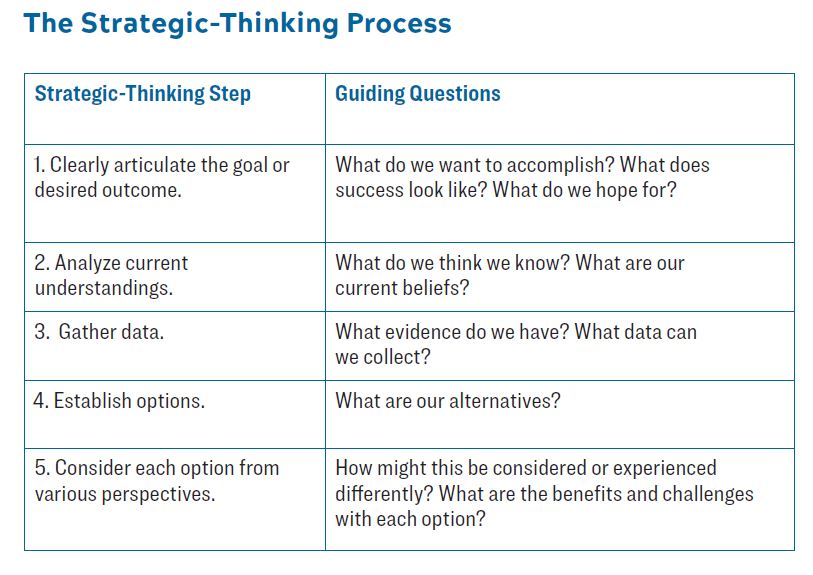 This article appeared as “Process Makes Perfect” in the Summer 2022 issue of Independent School.
This article appeared as “Process Makes Perfect” in the Summer 2022 issue of Independent School.One of the most important duties of an independent school board is to hold the school in trust not only for this generation of students but also for future ones. Thus, an independent school board leads by focusing on long-range strategy.” This NAIS Trustees’ Guide guidance for board members is a common directive—boards must focus on the future, think and act strategically, and “stay out of the weeds.” Most school leaders recognize and support this charge. In a 2018 NAIS Governance Study, when asked about the primary responsibilities of a board, heads of school and board chairs had the same two top responses: ensuring the financial stability of the school and thinking strategically as a board. In that same report, however, 37% of heads reported that their boards did not perform well in the realm of strategic thinking.
In my role as a consultant to independent schools, I find that most of the board members I talk with understand that they need to be strategic and focus on the long-term stability and sustainability of their school. Yet they tell me they don’t think they are doing it well because they don’t know exactly how to think strategically. They find themselves focusing on the operations of the school because that’s what they are familiar with, and they struggle to be able to plan for a complicated future. It seems that we tell board members they need to be strategic, yet we don’t provide them with the tools and resources to fulfill their responsibility.
Independent school board members are highly accomplished and intelligent people who are passionate about supporting their schools. They are dedicated and hardworking. But they often have more familiarity with planning and executing than strategizing. Board governance is complex, and it requires board members to take a different kind of role in organizational leadership and to use a distinct set of skills and practices to look to the future. Boards have a great deal of responsibility for a school—legally, financially, and programmatically—yet board members are not in charge of (nor should they be directly involved in) the day-to-day operations.
And, unfortunately, many schools fail to fully orient and train trustees in governance roles and practices, including how to think and plan strategically, which leaves them wondering how to successfully fulfill their responsibilities. But there is a straightforward process boards can use to build their collective strategy muscles; the more trustees get into the habit, the better their strategic thinking skills become.
A Process for Strategic Thinking
In our society, “strategy” has been so overused that its meaning is often misunderstood or misconstrued. I define strategy as the method or pathway used to achieve goals and strategic thinking as the process used for making the decision about which pathway is the most beneficial or advantageous. Strategic thinking differs from everyday planning and goal-setting in that it uses a process that includes considering data and identifying various pathways or possibilities to inform decisions. Many people naturally think strategically and make decisions after gathering data and weighing the merits of different options. Others make more “seat-of-their-pants” or “gut reaction” decisions, relying on intuition. For boards, it is important to think, plan, and decide on the basis of sound data and after sufficient, well-considered thought.There is a body of research that has demonstrated that people’s typical decision-making processes are biased. Often in groups we neglect to pay attention to how we make decisions. We focus solely on the outcome, without considering the process. Presenting a set of data—such as financial reports or enrollment trends, or an idea such as raising tuition—in a boardroom, discussing those data or ideas in a large group, and then moving directly to deciding upon a course of action can lead to faulty thinking. And admiring problems and engaging in off-topic conversations can derail the board’s work without a clear path forward.
Experts who study group efficacy and decision-making recommend following a clearly articulated process when making a complex decision or one that has a significant impact on people. Engaging in such a process for strategic board work doesn’t have to be complicated or time-consuming. But each step should be carefully thought through to ensure that group decision-making focuses on the conversations and considerations that will result in the best outcomes for the school. (See “The Strategic-Thinking Process” on next page.)
Strategic Steps
There are five steps boards can take to help reduce bias and support strategic thinking when making an important decision.- Clearly articulate the goal or desired outcome. Goal articulation must be the first step in any decision-making process, yet it’s often one that doesn’t receive enough time and attention. Carefully describing exactly what you hope to achieve or accomplish sets the stage for clarity throughout the process.
- Analyze current understand-ings. People often assume that other group members perceive a situation or topic in the same way they do. However, board members will likely come to a discussion with varied and disparate beliefs and understandings about an issue. It’s important to gain clarity about the group’s perspectives and try to get on the same page before launching into problem-solving or decision-making. Once you have everyone’s perceptions (and misperceptions) on the table, you can move on to the next step.
- Gather data. Boards need data—numeric or qualitative—to help confirm, support, or disprove the group’s understandings and to craft options or establish paths forward. Such supportive data can include information school personnel have already gathered, like an end-of-the-year survey, or new data the board initiates, such as focused listening sessions, demographic data, and so on.
- Establish options. In most situations, there are multiple ways that boards can proceed with making decisions. Board members sometimes become enamored with initial ideas and move forward without considering whether there are different, perhaps better, choices. It is important to spend time considering various options to ensure objectivity and thoroughness.
- Consider each option from various perspectives. Once several viable options have been identified, boards should consider them from different perspectives. Considerations might include: What are the overall benefits and challenges of each option? How do the different options support the school’s mission and financial plan? Who will benefit from each option? Who might not? This is the time to consider your options through the lens of people from different backgrounds and social identities. Once boards have gone through the process of considering different data-informed options from a variety of perspectives, they are better prepared to make a strategic decision about how to move forward.

Best Practice
Important, impactful decisions require time and attention, taking the time to engage in these five strategic-thinking steps will lead boards closer to solutions and decisions that achieve their goals. Nonetheless, often the issue is in taking the time. Boards have so much to accomplish that they don’t feel they have the ability to slow down and focus on process. But this leaves them open to bias and, potentially, to making decisions based on faulty thinking.As with any process, practice improves efficacy and efficiency. When boards begin using the five strategic thinking steps, it may feel awkward. However, the boards I have worked with have found that these steps become easier the more they engage in them. Board members have found that when they actively and routinely practice strategic thinking, they’re able to reduce bias and accomplish more—and they’re even more satisfied and engaged.
If a school’s board does not fulfill its responsibility and pay attention to the future viability of the organization, chances are, no one else will. But expecting that board members will be able to accomplish this incredibly important responsibility without training or practice is unrealistic. Board leaders need to spend time thinking, planning, training, and modeling how to make strategic decisions to ensure that their school makes the best decisions and has the most effective governing body possible.